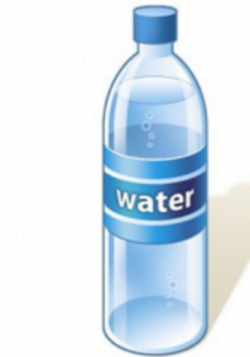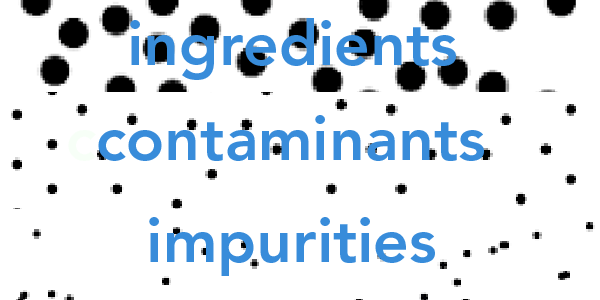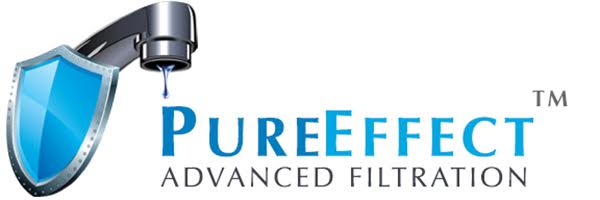The Limitations
I’ve been using the terms “nontoxic” and “toxic free” to indicate products since I began writing on the subject in 1982.
But there is a limitation to these terms that I want to be very clear about.
Most people think “toxic free” and “nontoxic” mean there are zero toxic substances in the product. I understand. I used to think that too.
But not only is that not the case, it is impossible to achieve.
In common usage, nontoxic and toxic-free mean that no substances known to cause harm have been intentionally added to the product as an ingredient. But toxics go deeper than the ingredients on the label.
Ingredients, Contaminants, and Impurities
In today’s world it is nearly impossible for a product to be made with zero toxic exposures.
On the label of the product, we are given the basic ingredients, but what is not given are the toxic contaminants or impurities.
My definition of contaminant with regards to materials used to make consumer products is any substance that is added to the product, but which is not an intended ingredient. Some contaminants are benign, and others may cause harm. An example of a contaminant would be BPA leaching into food from a plastic package, or residues of pesticides remaining on food. In the dictionary, a contaminant is “something that makes a place or a substance (such as water, air, or food) no longer suitable for use.”
I consider impurities to be toxic substances that are present in in a material that is something other than the material itself. For me, an impurity doesn’t come from outside the product, but is inherent in the material itself as a result of incomplete manufacturing processes or environmental pollution. Since the mid 1940s the entire Earth has been increasingly polluted with a variety of toxic chemicals, even in such non-industrial places as the Arctic Circle. It is known that certain pesticides are everywhere on Earth, heavy metals are everywhere, fluoride is everywhere. So there are few, if any, raw materials anywhere on Earth that are completely free from impurities.
Here’s an example of ingredients, contaminants, and impurities
 | A bottle of water contains: Ingredients: Water Contaminants: chlorine, flouride, BPA from plastic bottle Impurities: sand, silt, clay, silicates, chlorides, fluorides, bicarbonates, sulfates, phosphates, nitrates, iron, compounds, pesticides, herbicides, detergents, carbonic acid, bacteria, fungi, algae and more |
And of course all these contaminants and impurities are in each product to greater or lesser degree, so we cannot say with any certainty what exactly is in any given sample without testing.
But by far, the most important thing to be concerned about is to eliminate the toxic substances that are intentionally added to products as ingredients, for they are by far present in much greater quantity. Once we remove the most obvious toxic exposures, then we can begin to eliminate contaminants and impurities.

Some contaminants are easy to identify and can therefore be eliminated without much trouble. Plastic contaminants from water bottles, BPA contaminants from the lining of food cans, and pesticide contaminants from growing food are all known to exist even though they are not intentionally added as ingredients or listed on the label. And they are known to have health effects even in these small quantities. I’m always looking for these contaminants and consider them in my recommendations.
But the most difficult to identify and about which the least is known are the impurities. At this point in time, I’m not considering impurities in my Recommendations, but will as I learn more about them and where they are found.
Individual Tolerance
Another reason why it’s difficult to claim that a product is nontoxic or safe for everyone at all times is because whether or not a specific chemical is toxic to a specific body is a yes-or-no question. It’s an evaluation of risk as to whether or not something is likely to cause harm.
Every day we evaluate the potential for harm of many different things. For example, how safe is it to cross the street? There might be danger. We could get hit by a car. But does that mean we will never cross the street? No. We look both ways and when there are no cars approaching, we cross with confidence that we will be safe.
It’s the same with toxic chemicals in consumer products. There are no absolutes.
Here’s why.
First, every individual body is different. Whether or not a chemical causes harm in your body depends on:
- The inherent danger of the chemical
- The amount of the chemical you are exposed to
- How frequently you are exposed to it
- Other chemicals you are being exposed to at the time or have been exposed to in the past and are now being stored in your body
- How healthy your body is, and
- Your age (babies and children, for example, do not have fully developed body systems, and the body systems of the elderly are worn).
In addition, body size makes a dramatic difference in how it is affected by a chemical exposure. You could have, for example, 100 parts per million formaldehyde in a room and the exposure would be very different for a 10 pound baby, a 50 pound child, a 120 pound woman or a 200 pound man.
Also, each individual body has its own set of limitations, which could be in the form of allergies, sensitivities, intolerances, foods that raise blood sugar, and the like. One cannot possibly factor in all these possible health effects that are often individual in nature.
Doing Our Best To Reduce Toxics DOES Make A Difference
Despite all the variations and uncertainties, there is something each of us can do that makes a difference: We can learn which chemicals are known to be harmful and do our best to eliminate our exposures to these chemicals of concern.
More specifically, what each of us can do to determine if a specific product might be toxic to our own bodies is:
- look at the degree to which the substances and materials are likely to cause harm
- evaluate what that harm might be to ourselves individually
- choose those that have the lowest risk.
My experience has been that reducing exposure by eliminating the chemicals known to be toxic can make a dramatic difference in health, even if they are not eliminated 100%.
Other Limitations
At this point in time, my work is limited to the known health effects that may be caused to the end user consumer of a product. All I can look at is the ingredients list available to me on the label or website, or given to me by the manufacturer.
But there are three other aspects that ultimately need to be considered.
One is the supply chain. This is the entire chain from taking the raw material from the Earth to putting it in the final product. Most manufacturers know nothing about their supply chains and those that attempt to evaluate their supply chains often have difficulty getting information. Where information is available on supply chain, I will include it in my materials review, but I can’t require it because it’s so infrequently available.
I also at this time am not considering the environmental effects of the materials. Again because data is limited and also because a consumer’s first concern is “Will the product harm my health and the health of my loved ones?” However, any toxic chemicals eliminated from use by consumers for the benefit of their health, also benefits the environment.
My intent is to include these supply chain and environmental effects in the future.
One factor that may never be possible to include are the synergistic effects that occur between chemicals. Only recently scientists have learned that certain chemicals which do not cause cancer alone can cause cancer when they are combined. This tendency for effects of chemicals to worsen in unpredictable ways when combined is one of the reasons I have long recommended to avoid as many toxic chemicals as possible in daily life.






